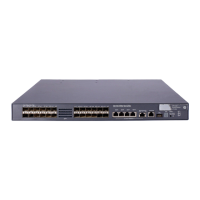167
To configure selective QinQ:
To do... Use the command... Remarks
1. Enter system view
system-view —
2. Create a class and enter class
view
traffic classifier classifier-name
[ operator { and | or } ]
Required.
By default, the operator of a class
is AND.
3. Specify the inner VLAN IDs of
matching frames
if-match customer-vlan-id vlan-id-
list
Required.
4. Return to system view
quit —
5. Create a traffic behavior and
enter traffic behavior view
traffic behavior behavior-name Required.
6. Specify an outer VLAN ID
nest top-most vlan-id vlan-id Required.
7. Return to system view
quit —
8. Create a QoS policy and
enter QoS policy view
qos policy policy-name Required.
9. Associate the traffic class with
the traffic behavior defined
earlier
classifier classifier-name behavior
behavior-name
Required.
10. Return to system view
quit —
Enter Layer 2
Ethernet
interface view
interface interface-type interface-
number
11. Enter the
Ethernet
port view
of the
customer
network-
side port
Enter port group
view
port-group manual port-group-
name
Required.
Use either command.
• Settings made in Layer 2
Ethernet interface view take
effect only on the current port.
• Settings made in port group
view take effect on all ports in
the port group.
12. Enable basic QinQ
qinq enable Required.
13. Apply the QoS policy to the
incoming traffic
qos apply policy policy-name
inbound
Required.
CAUTION:
• Selective QinQ enjoys higher priority than basic QinQ. A received frame is tagged with an outer
VLAN ID based on basic QinQ only after it fails to match the match criteria defined in the traffic
class.
• Selective QinQ is achieved through QoS policies. For more information about QoS policies, see the
ACL and QoS Configuration Guide
.
Configuring an inner-outer VLAN 802.1p priority mapping
The HP 5800&5820X switches series achieve the following inner-outer VLAN 802.1p priority mapping
modes through QoS policies:
• Marking the 802.1p priorities in outer VLAN tags according to the inner VLAN IDs or the 802.1p
priorities in the inner VLAN tags.

